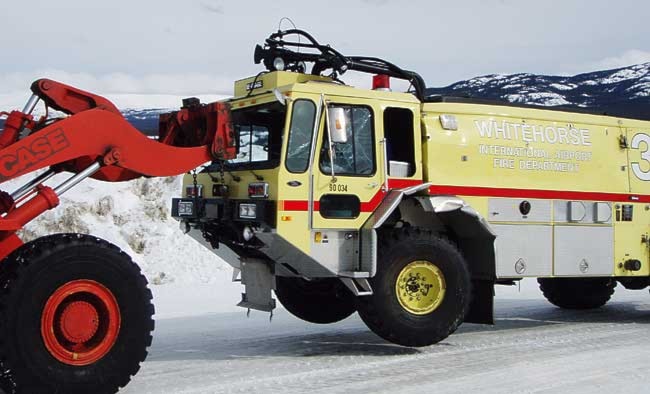Airport firefighting vehicles can withstand heavy fog, searing heat and offroad conditions, but it only took a patch of ice to severely damage one of the Erik Nielsen Whitehorse International Airport’s firefighting fleet on Wednesday.
Firefighters were performing a routine crash alarm simulation.
“It wasn’t just a lollygag to the end of the airport for a scenic drive,” said airport manager John Rogers.
The airport’s E-One Titan screamed out of the fire hall, took a sharp right towards the runway and struck a patch of icy ground.
In “slow motion,” the multi-ton truck keeled onto its side, said an observer.
The impact blew out the windows in the driver compartment, crushed fenders and mirrors along the driver’s side and twisted the truck’s rear superstructure.
Fluid gurgled out of the fallen behemoth, forming a pool of grey liquid around the crash site.
“Ice and snow builds up at all times, and our snow-removal practices keep them in check, but we’re in the Yukon, and snow and ice is a normal part of the area in which we live,” said Rogers.
The driver was not wearing a seatbelt, but only suffered minor cuts and bruises.
Seatbelts are routinely forgone in fire vehicles, owing to critical time lost in buckling and unbuckling the belts.
Typically, airport fire vehicles are expected to be at the site of a crash within 30 seconds.
Following the crash, the airport announced seatbelts would now be required on all emergency responses.
In December, one of the airport’s firefighting fleet was retired following the delivery of a new $800,000 Striker fire truck. That old truck had been in service since 1988 and had logged more than 50,000 kilometres, most in training exercises.
“(Permanent retirement) was the original plan ... but we’re pleased to say that it will serve another useful purpose,” said Rogers.
Every emergency call always prompts the dispatch of two trucks. If a jet had actually plowed into the tarmac, another vehicle would still have been on hand to manage the emergency.
Extensive repairs will be needed before the Titan can return to action, if ever.
“Our transportation maintenance branch is looking at the vehicle, and we’ll do a complete assessment to find out exactly what will happen,” said Rogers.
Contact Tristin Hopper at
tristinh@yukon-news.com
